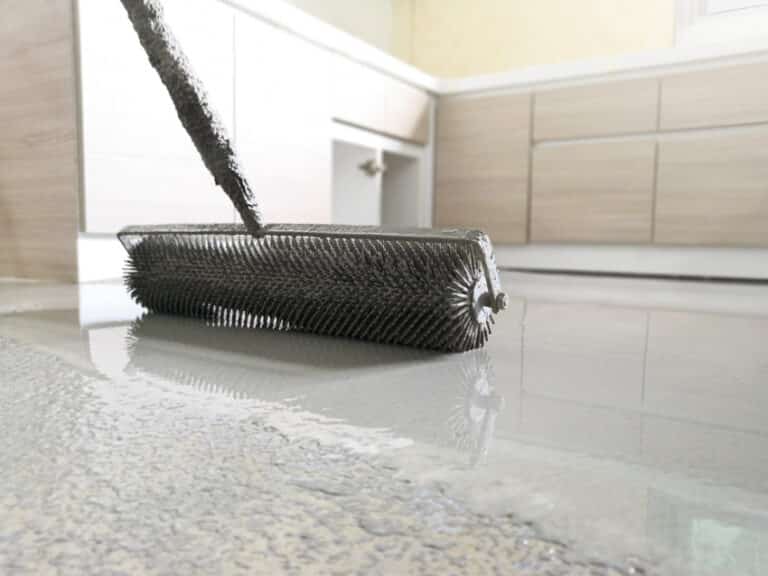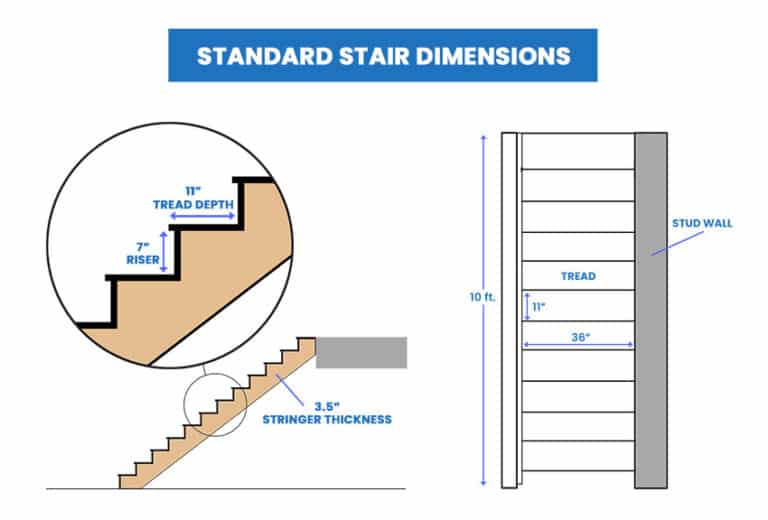Enamel vs Latex Paint (Differences & When To Use)
Wall painting does not just add to the interior of a home; it also adds personality. It can also change one’s mood and spread good vibes around. Choosing a color is easy, but where do you begin to plan everything else? Some homeowners may be oblivious that there are different types of paint, and some wall finishes require one or the other. In this article, we’re focusing on enamel vs latex paint. Knowing their differences and the paint a wall needs is essential before purchasing for the best results.
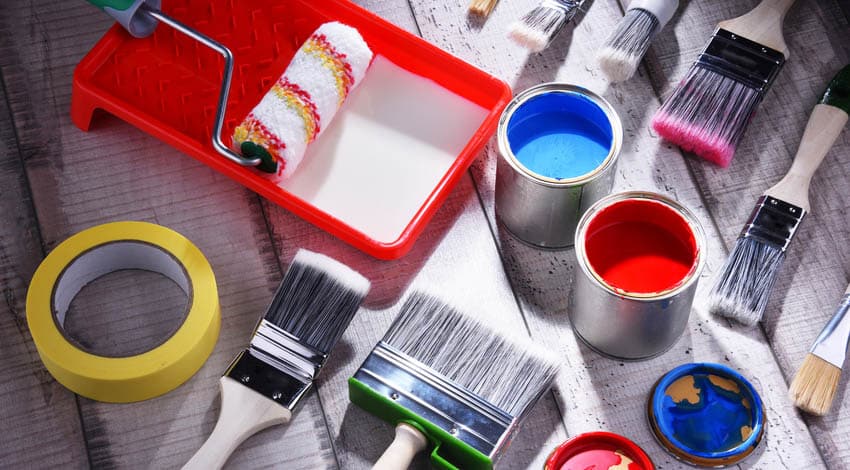
We are also discussing precisely the best brush to use for each paint type and whether or not you can mix enamel and latex paint together.
Difference Between Latex And Enamel Paint
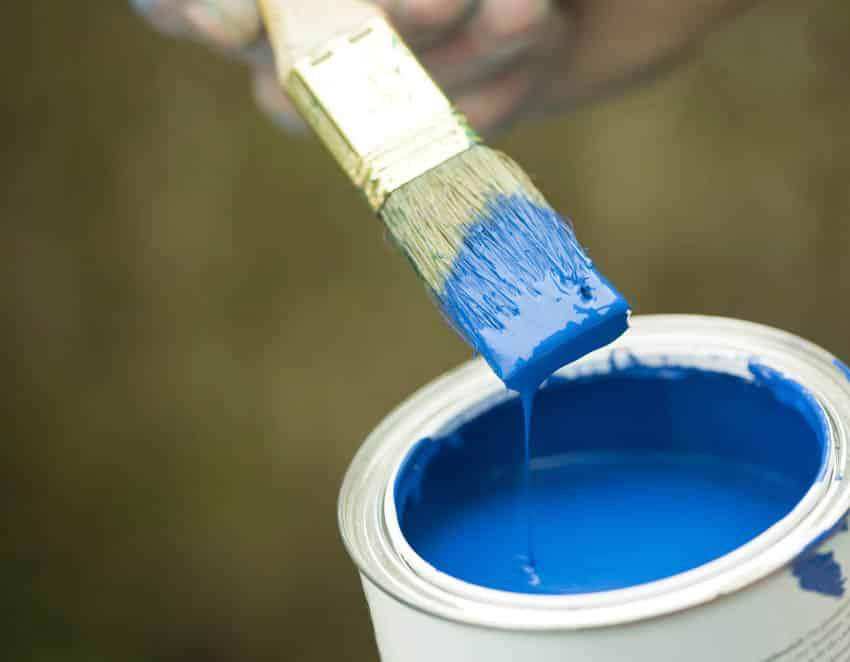
Here are the various significant differences between latex and enamel paint.
Paint Base
A significant distinction between the two is their paint base. Enamel is an oil-based product that dries slower and has a hard, glossy surface finish.
Enamel paints are usually best for hard surfaces. Nearly all enamel products are alkyne resin-based, albeit some add varnish to enamel paints.
Latex paints, also known as acrylic paint, are water-based paints with glycol ethers as a solvent that dry quickly and are more malleable. This type of paint is best for surfaces like unprimed drywall, a brick wall, or stonewall — surfaces that may expand.
Interior and Exterior Use
Which of the two work well with interior or exterior painting jobs, respectively?
Enamel paints had been the standard for a long time before innovations in water-based acrylic paints were made. Professional painters still believe that enamel paints deliver a better finish, but latex is the way to go for the do-it-yourself homeowner.
Enamel paints generally hold up better than latex ones, covering more smoothly and thoroughly with a single coat, and it lasts longer. It also covers metal better than acrylics would ever do.
Enamel paints also maintain their hold and color under the elements, but lighter enamel paints have the tendency to yellow under the sun over time.
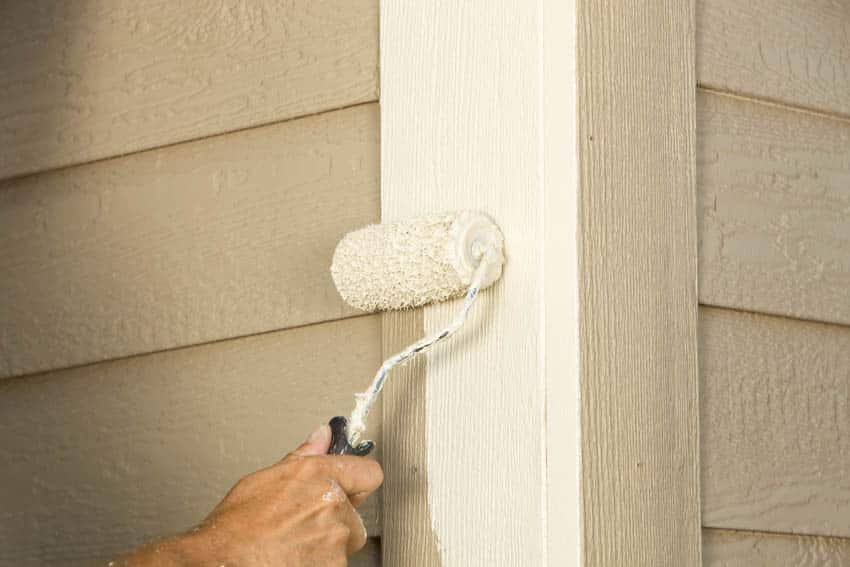
Latex paints, on the other hand, offer flexibility and convenience. Two coats are needed to achieve an opaque finish, but painting jobs for the exterior part of any home can now be done even in colder weather, as latex paints tend to dry quickly.
Innovations made in acrylic paints, such as mold-resistant, adhesion performance improvements, and specialty-made latex exterior paints, have made the latex-based colors versatile in the house’s interior and exterior parts.
Latex paints, as they are water-based, cover some materials a little differently than oil-based paints would. An example of this is in latex paint performance with metal and wood. Oil-based paint does a better job covering these materials, as latex paint also tends to swell the wood.
So, what works better with each? The water base of latex makes it malleable, thus causing it to expand and contract with surfaces such as home siding. Oil-based paint does not stretch, which can be shown by cracks appearing on walls due to moisture traps under the paint.
Finishes
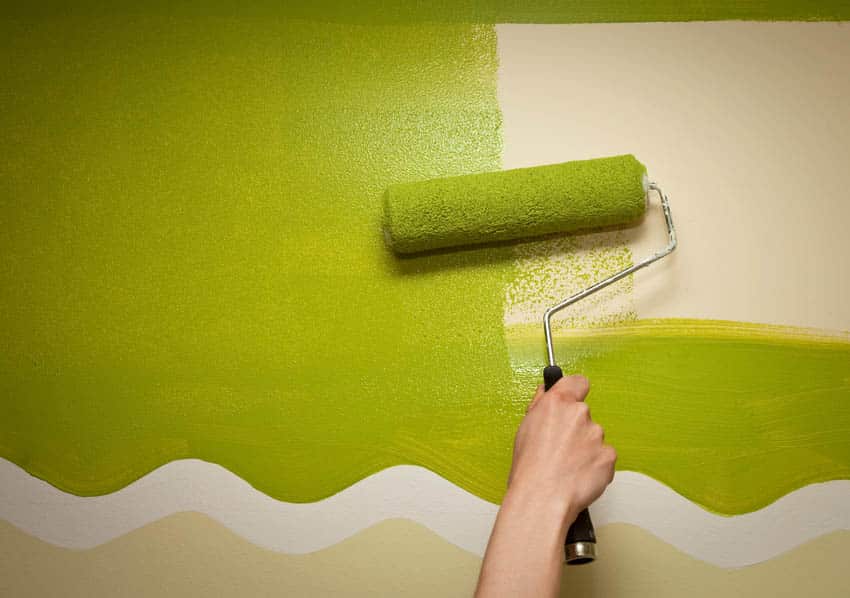
Latex paints can achieve the eggshell and flat finish — opaque, sophisticated, and popular amongst homeowners with little to no luster that works brilliantly for interior walls and ceilings.
Latex paint finishes don’t clean well, so it’s not advisable to have them in kitchens, bathrooms, or for a kid’s bedrooms.
In contrast, you can achieve a satin, semi-gloss, and high gloss finish with enamel paint. These finishes are generally easier to clean and more stain-resistant, making them an excellent choice for rooms that receive the most activity, like the kitchen, bathroom, and kids’ bedrooms.
Durability
Water-based paints are easier to clean and remove, but enamel paints take the cake for durability and longevity.
Enamel paints dry harder than latex ones withstanding climates in the outdoors. They will fare better in areas that require a high level of maintenance or areas that have exposure to moisture and have more dampness than usual, such as the kitchen or the bathrooms. Enamel paint is more rigid and highly washable.

The only problem with enamel paint is that sometimes harsh chemicals are needed to be mixed with curing them. Oil-based paints also emit volatile organic compounds that could be bad for the lungs if not using protective gears like a gas mask. Enamel paints also crack and yellow over time.
However, when mixed in with acrylic binder, latex paints can give the enamel paints a run for their money in terms of durability.
Drying Times
Another part of your decision is the number of days you want to dedicate to painting around the house. This is dependent on the drying time, and latex and enamel paints differ drastically in this area.
Typically, oil-based enamel paint dries to touch within six to eight hours, but one has to wait for twenty-four hours for a recoat.
Latex, on the contrary, dries pretty fast. It dries to touch in an hour and should be ready for a recoat in four.
However, also make sure to check the paint labels as manufacturers sometimes specify their suggested drying time.
Safety
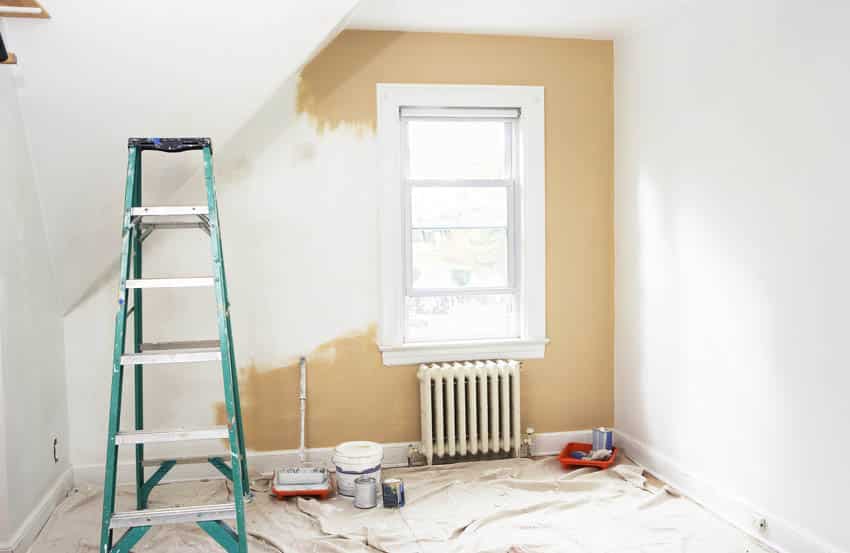
Paints are made of chemicals; some can make you feel lightheaded and give you headaches more than others. This is the case with oil-based enamel paint, which uses less sustainable ingredients.
Some oil-based enamel paints are regulated due to their flammability and VOCs in their formula. Nonetheless, both paint variants are considered hazardous waste when disposed of.
Ventilation is essential, and using protective gears when painting is essential. This is because the air trapped in the room, especially for windowless areas, can make you feel dizzy and cause skin irritations if exposed for a while.
Gloves, protective glasses or goggles, paint masks, coveralls, and shoes — the whole nine yards. A fan could also be used for painting rooms with poor ventilation.
Ladder safety is often overlooked, and checking if the ladder is stable could save the homeowners from potential falls and injuries.
Sustainability also comes with safety. Almost always, latex paints are the more sustainable option. Enamel and other oil-based paints are less sustainable in producing and releasing VOCs into the air.
When To Use Enamel Paint

Enamel paints, as stated, tend to dry harder, making them more durable and more ideal for wear and tear. Enamel paints are suitable in the kitchen, which is often exposed to stains and dirt.
It’s durable and washable, making cleaning up in case of accidents easier. It’s also advisable to use the glossier finish of enamel paints in bathrooms to match the shiny bathroom’s hardware. See more best paint finish for bathrooms here.
Enamel paints are also a great match for window and door edges, making them look nice and clean even without regular wiping.
Enamel paints are also used to paint manufactured appliances as enamel sticks better with stainless steel and metal.
When To Use Latex Paint
Latex paints dry quicker, making it work efficiently if the homeowners are in a time crunch. Latex is also typically used for most DIY painting projects.
Ceilings are often painted white as lighter colors reflect light into the room from the window, making the room feel larger while providing natural lighting.
Latex paints are suggested when you have a large or long portion of the wall or the ceiling to be painted as they are water-based and coat evenly and thinly.
Latex paints are also environmentally responsible and provide outstanding color retention as time goes by. If you want a solid opaque colored wall, then latex paints are the way to go. Read more about paint finishes for ceilings here.
What Brushes To Use For Enamel And Latex
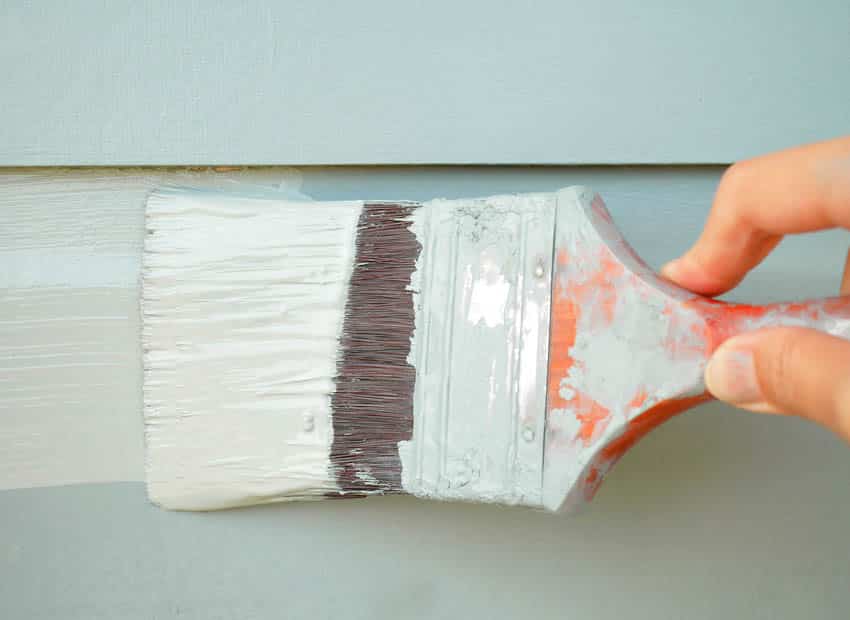
Working with enamel paint can be hard when the homeowners are not using the right tools. Applying enamel paint requires flexible and soft bristles that can be found on non-synthetic natural hair brushes.
Stiff or synthetic brushes could leave an uneven finish and leave brush marks and stray brush strands on the surface. Natural bristles are pitted and can absorb water, making them swell and be soft and limp, easy to maneuver.
When working with latex paints, it is the other way around. Synthetic brushes are more advisable because a natural bristle brush becomes listless and less effective when soaked in water. Low and no-VOC paints, most of which are water-based, are best applied with synthetic brushes, too.
Can You Mix Latex With Enamel?
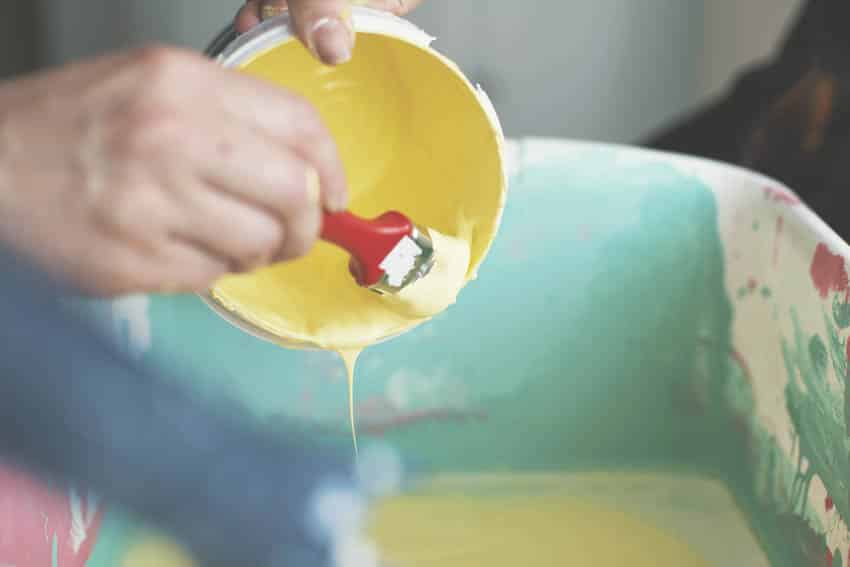
In answering that question, we look into the fact that oil doesn’t mix well with water. This is because this mixture is immiscible. This signifies that oil molecules will stick better to other oil molecules, and water will be attracted to other water molecules.
Thus, only oil-based paint is advisable to mix with oil-based paint, and water-based paint is better when combined with other water-based paints. You can mix them, possibly, but it could not make for a durable finish as both paint types contrast each other quite significantly.
It’s a different case when talking about painting over each other. With a bit of groundwork, you can add a layer of latex above an oil-based painted area. This process will involve sanding the surface, deep cleaning, and priming for the paints to mix.
Consider these differences between enamel and latex so that you can make an informed decision about which paint to buy and apply based on your needs.
For more related content about enamel vs latex paint, check out our guide to the best paint finish for living rooms.

